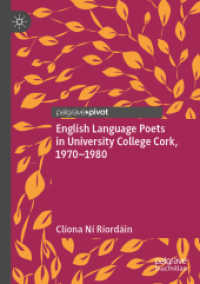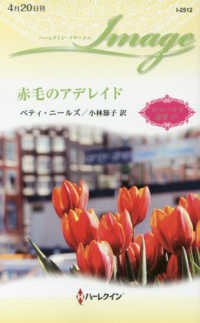Full Description
This book brings together multiple theoretical perspectives and disciplinary approaches to study the acquisition and development of written language by children as well as the implications for teaching and learning of writing practices in a variety of languages and cultural contexts. Chapters in this contributed volume present both theoretical contributions and results of research carried out with students and teachers from 11 countries (Belgium, Brazil, Chile, Israel, Italy, Mexico, the Netherlands, Portugal, Spain, UK and USA) who speak seven different languages: Portuguese, Spanish, English, Italian, French, Dutch and Hebrew. By bringing together research developed in diverse cultural contexts it enriches the debates in the interdisciplinary field of writing studies by analyzing a wide range of topics at the interface between research and educational implications for the teaching and learning of writing by children.
The book consists of five parts, each one addressing a specific set of topics. Part I presents studies on topics related to written language representation systems (phonological and morphological awareness) and on the relationship between grammar and the quality of texts of different genres. Part II includes studies related to compositional processes of writing texts, and the factors involved in these processes. Part III focuses on the difficulties faced by students during the acquisition and development of writing. Part IV is dedicated to chapters that discuss and compare writing practices in different social environments. Finally, chapters in part V deal with teaching and learning of writing in the school setting.
Development of Writing Skills in Children in Diverse Cultural Contexts: Contributions to Teaching and Learning will be of interest to researchers and students in the fields of psychology, education and linguistics, as well as to other social scientists in the broader interdisciplinary field of writingstudies.
Contents
Chapter 1. Development, teaching and learning of writing: from word to text.- Part I. Spelling, vocabulary and grammar in written texts.- Chapter 2. Learning to spell in Brazilian Portuguese: children's patterns of spelling errors and unconventional word segmentation.- Chapter 3. Grammar as a resource for developing metalinguistic understanding about writing.- Chapter 4. The role of grammar and vocabulary for writing instruction in school.- Part II. The composition processes of writing texts.- Chapter 5. "Who is going to read the story that I have written?" The role of the audience in textual revision made by children.- Chapter 6. The effect of low-level writing process on written narrative textual competence in kindergarten and primary school children.- Chapter 7. Grammatical choices and narrative quality in the collaborative writing of primary school students.- Chapter 8. The development of rhetorical preferences in the analytical writing of Spanish students from elementary to highereducation.- Part III. Difficulties in acquiring and developing writing skills.- Chapter 9. Morphological analysis and its impact on written language development in children with and without language disorders.- Chapter 10. Difficulties in acquiring and developing writing skills.- Part IV. Writing practices in different social environments.- Chapter 11. Nurturing writing of narrative and expository texts at the preschool level.- Chapter 12. Writing technique or writing culture? Representations of writing among children and teachers at high achievement schools in Chile.- Chapter 13. Rewriting the book: new literacy practices and their implications for teaching and evaluating writing.- Part V. Teaching and learning writing in the classroom.- Chapter 14. Teaching writing through discourse genres.- Chapter 15. Teaching of argumentative writing in Romance languages: a meta-analysis.- Chapter 16. The Chilean National Writing Plan: rationale, actions and preliminary results.- Chapter 17. Effects of research-based teacher training on writing instruction practices.- Chapter 18. Writing to understand and being understood: basic design principles for writing instruction.- Index.








